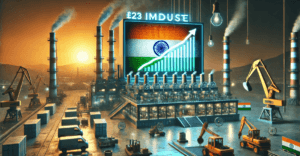India to End $23 Billion Manufacturing Boost—What Went Wrong?
The Indian government plans to discontinue its $23 billion Production-Linked Incentive (PLI) scheme, which was introduced in 2020 to boost domestic manufacturing and increase its share of the economy to 25% by 2025. Despite requests from industries, officials have confirmed that the scheme will not be extended beyond the 14 pilot sectors. The program provided financial incentives to companies meeting production targets, attracting major firms like Foxconn and Reliance Industries. However, many businesses faced delays or failed to start production due to bureaucratic hurdles and compliance issues.
By October 2024, only 37% of the production target had been met, with just $1.73 billion in incentives disbursed. Instead of growing, manufacturing’s share of India’s economy declined from 15.4% in 2020 to 14.3% in 2024. The government is now considering alternative strategies, such as reimbursing investment costs to support companies more effectively. Despite the overall shortfall, the scheme saw notable success in mobile phone and pharmaceutical production.
Mobile phone manufacturing surged to $49 billion in FY24, marking a 63% rise since 2020-21, while pharmaceutical exports nearly doubled over the past decade, reaching $27.85 billion in FY24. Though the PLI scheme did not fully meet expectations, India remains committed to strengthening its manufacturing sector.

India to End $23 Billion Manufacturing Boost—What Went Wrong?
India’s ambitious $23 billion initiative to boost domestic manufacturing is coming to an end, as the government has decided not to extend or expand the program. Launched in 2020, the Production-Linked Incentive (PLI) scheme aimed to increase manufacturing’s contribution to the economy from 15.4% to 25% by 2025 and attract global companies looking to reduce their dependence on China. However, officials have confirmed that the scheme will remain limited to its original 14 sectors, such as electronics and pharmaceuticals, and that deadlines for meeting targets will not be extended despite industry requests.
Mixed Results and Missed Targets
The PLI scheme offered financial incentives to companies that met production goals. It attracted major players like Foxconn (a key Apple supplier) and Reliance Industries, but many businesses faced challenges. Some struggled to start production, while others experienced delays in receiving incentives due to bureaucratic inefficiencies. By October 2024, companies had produced goods worth $151.93 billion under the program—only 37% of the original target. Additionally, only $1.73 billion in incentives had been disbursed, accounting for just 8% of the allocated funds. Instead of expanding, manufacturing’s share of India’s economy declined to 14.3% in 2024 from 15.4% in 2020.
Challenges Faced by the PLI Scheme
Several factors contributed to the program’s struggles. Complex rules and lengthy approval processes made it difficult for companies to qualify for payouts. Global supply chain disruptions, exacerbated by the pandemic and geopolitical tensions, slowed production timelines. Additionally, some sectors lacked the necessary infrastructure and skilled workforce to scale operations effectively. While industries such as solar panels and batteries showed limited progress, others, like textiles, saw minimal participation.
Success Stories: Mobile Phones and Pharmaceuticals
Despite the overall shortcomings, certain sectors flourished. Mobile phone manufacturing surged to $49 billion in FY24, marking a 63% increase since 2020–21, largely driven by Apple’s expanding production in India. Pharmaceutical exports also performed well, nearly doubling over the past decade to reach $27.85 billion in FY24. These achievements demonstrate India’s potential in high-value industries, particularly as global companies seek alternatives to China.
Future of Indian Manufacturing
The government remains committed to strengthening domestic manufacturing and is exploring new strategies. One potential approach involves partially reimbursing companies for upfront investments to help them recover costs more quickly. This model aims to address a key flaw of the PLI scheme, where businesses often faced long delays in receiving incentives after setting up operations. A reimbursement-based policy could improve cash flow, encouraging faster expansion.
Simultaneously, India is prioritizing infrastructure development, regulatory simplifications, and workforce training to create a more business-friendly environment. States like Tamil Nadu and Karnataka, which have emerged as hubs for electronics and electric vehicle (EV) manufacturing, are expected to play a key role in these efforts.
Lessons from the PLI Scheme
The PLI scheme’s mixed results provide valuable insights. While targeted incentives can drive growth in specific industries, smoother implementation and quicker disbursement of funds are essential for success. The government must also work closely with industries to address red tape and skill shortages. For example, in India’s semiconductor sector—a national priority—delays in approvals and land acquisition have stalled several projects.
Continued Global Interest in India
Despite the scheme’s challenges, international companies continue to view India as an attractive alternative to China. Major firms like Samsung, Boeing, and Micron have announced new investments. To maximize this interest, India must align its policies with manufacturers’ needs, offering not only financial incentives but also reliable infrastructure, regulatory stability, and ease of doing business.
Conclusion
Although the PLI scheme did not fully achieve its objectives, it highlighted both the potential and the challenges of India’s manufacturing sector. Moving forward, the government is likely to focus on creating a sustainable industrial ecosystem rather than relying on short-term incentives. The success of sectors like electronics and pharmaceuticals proves that with the right support, India can expand its role in global supply chains. While challenges remain, the country’s push to become a manufacturing powerhouse is far from over.
You must be logged in to post a comment.